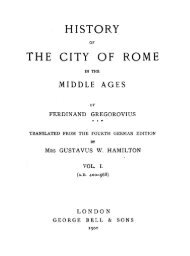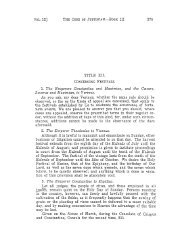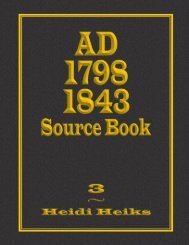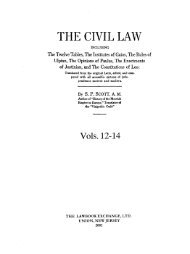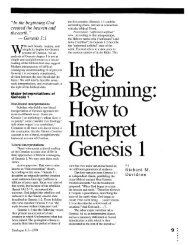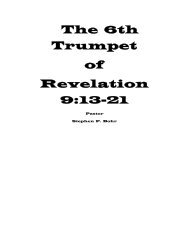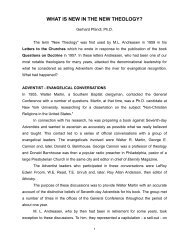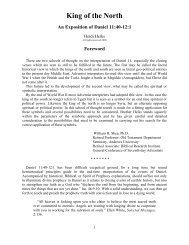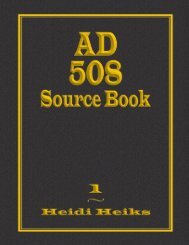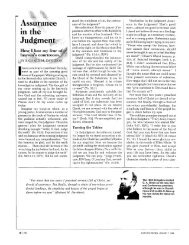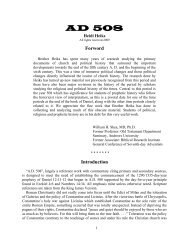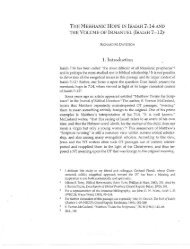Create successful ePaper yourself
Turn your PDF publications into a flip-book with our unique Google optimized e-Paper software.
<strong>Judgment</strong> <strong>in</strong> <strong>Daniel</strong> 7cate nom<strong>in</strong>ative ("white," "pure") by way of a comparative preposition("like") <strong>in</strong> a pattern ofA:B: :A:B <strong>in</strong> terms ofpoetic form. In verse lOb thenumerical statements ("thousand thousands," "ten thousand ten thousands")ofbothcola areeach followed by theirverbal statements ("served,""stood") <strong>in</strong> the same pattern ofA:B: :A:B.These parallel and advanc<strong>in</strong>g numerological statements of verse lOb("thousand thousands" to "ten thousand ten thousands") are <strong>in</strong>terest<strong>in</strong>g<strong>in</strong> view ofthe use of this poetic technique elsewhere <strong>in</strong> the Hebrew Bibleand <strong>in</strong> Canaanite poetry. For example, the description of the angelic host<strong>in</strong> verse lOb proceeds from a smaller numerical statement about them toone that is larger and more comprehensive. The Hebrew Bible uses a numberofsimilar numerical poetic pairs:1. The 1/2 sequence-Job 33:14; Ps 62:112. The 3/4 sequence-Prov30; Amos 1-23. The 6n sequence-Prov6:16; Job 5:194. The 7/8 sequence- Mic 5:5; Ecc111:25. The 60/80 sequence- Song ofSol 6:86. The 70/80 sequence-Ps 90:107. The 1,000/10,000 sequence-l Sam 18:7; Ps 91:7Examples <strong>in</strong> Canaanite literature ofthe use ofthis type ofpoetic techniqueare seen <strong>in</strong> the "Legend of K<strong>in</strong>g Keret" that has been piecedtogether from a series oftexts found <strong>in</strong> the thirteenth century B.C. destructionlevel at Ugarit on the Syrian coast. K<strong>in</strong>g Keret's story <strong>in</strong>cludes the useof2/3, 3/4, 5/6, 7/8, and 70/80 sequences. 8It is evident that this k<strong>in</strong>d ofexpression was an ancient poetic way ofexpress<strong>in</strong>g completeness. The ultimate numerical pair <strong>in</strong> <strong>Daniel</strong> 7:10,therefore, takes <strong>in</strong> so vast an assembly <strong>in</strong> this heavenly assize that even thisk<strong>in</strong>d ofcomparison does not adequately describe <strong>in</strong> human terms the vastnumerical extent of the assembled throng.C + C'. The two central bicola of this stanza, verse 9c and verse lOa,develop the same theme-the glory surround<strong>in</strong>g the throne of God. Theexpression of that glory is conveyed through the use of the word "fire"(nar), that occurs <strong>in</strong> three of the four <strong>in</strong>dividual cola ("flames of fire,""burn<strong>in</strong>g fire," "streamoffire"). In addition, fire (or glory) is obviously thesubject ofthe verb <strong>in</strong> the second colon ofverse lOa ("and [fire] went forthbefore it").A m<strong>in</strong>or translation problem is <strong>in</strong>volved <strong>in</strong> <strong>in</strong>terpret<strong>in</strong>g the mascul<strong>in</strong>e8 Compare J. B. Pritchard, ed.,Ancient Near Eastern Texts, 143-48.118



